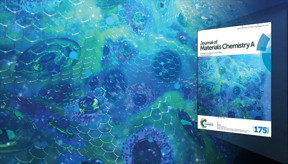Pumping up energy storage with metal oxides
Material scientists at Lawrence Livermore National Laboratory have found certain metal oxides increase capacity and improve cycling performance in lithium-ion batteries.
The team synthesized and compared the electrochemical performance of three graphene metal oxide nanocomposites and found that two of them greatly improved reversible lithium storage capacity.

This schematic illustration shows metal oxides tented inside graphene. Many metal oxide/graphene composites offer unexpected capacity synergy that helps to increase storage capacity.
Graphene-metal oxide (GMO) nanocomposites have become renowned for their potential in energy storage and conversion, including capacitors, lithium-ion batteries, catalysis (for fuel cells, water splitting and air cleaning) and sensors.
For applications in lithium-ion batteries, nanosized metal oxide (MO) particles and highly conductive graphene are considered beneficial for shortening lithium diffusion pathways and reducing polarization in the electrode, leading to enhanced performance.
In the experiments, the team dipped prefabricated graphene aerogel electrodes in metal ion solutions where all metal oxide nanoparticles appear to be anchored on the surface of graphene and are fully accessible to the electrolyte (i.e., open pore space).
"In essence, our approach helps to optimize the system-level performance by ensuring that most metal oxides are active," said LLNL material scientist Morris Wang and corresponding author of the paper.
The method can deposit most types of MOs onto the same prefabricated 3D graphene structure, allowing for direct comparison of electrochemical performance of a wide range of GMOs.
"We found that the experiments showed large reversible lithium storage capacities of graphene sheets, enabled by the unheralded roles of metal oxides," Wang said. "Surprisingly we saw the magnitude of capacity contributions from graphene is mainly determined by active materials and the type of MO bound onto the graphene surface."
Specifically, the lithium storage mechanisms of MOs and their loading ratio versus graphene play key roles in determining graphene capacity contributions.
Source: Nanotechnology Now
- 307 reads
Human Rights
Ringing FOWPAL’s Peace Bell for the World:Nobel Peace Prize Laureates’ Visions and Actions

Protecting the World’s Cultural Diversity for a Sustainable Future

The Peace Bell Resonates at the 27th Eurasian Economic Summit

Declaration of World Day of the Power of Hope Endorsed by People in 158 Nations

Puppet Show I International Friendship Day 2020

